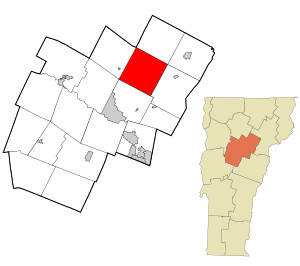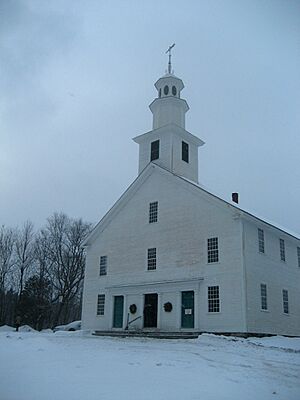Calais, Vermont facts for kids
Quick facts for kids
Calais, Vermont
|
|
|---|---|

Calais Town Hall
|
|

Location in Washington County and the state of Vermont
|
|
| Country | United States |
| State | Vermont |
| County | Washington |
| Communities |
|
| Area | |
| • Total | 38.6 sq mi (99.9 km2) |
| • Land | 38.0 sq mi (98.5 km2) |
| • Water | 0.6 sq mi (1.5 km2) |
| Elevation | 1,109 ft (338 m) |
| Population
(2020)
|
|
| • Total | 1,661 |
| • Density | 43.03/sq mi (16.627/km2) |
| Time zone | UTC-5 (Eastern (EST)) |
| • Summer (DST) | UTC-4 (EDT) |
| ZIP Codes |
05648 (Calais)
05650 (East Calais) 05640 (Adamant) 05658 (Marshfield) 05666 (North Montpelier) 05667 (Plainfield) 05682 (Worcester) |
| Area code(s) | 802 |
| FIPS code | 50-11350 |
| GNIS feature ID | 1462062 |
Calais is a town in Washington County, Vermont, United States. It's pronounced like "callous." In 2020, about 1,661 people lived here. Calais includes several smaller communities. These are Adamant, East Calais, North Calais, Kent's Corner, Maple Corner, and Pekin.
Contents
A Look Back at Calais's Past
Colonel Jacob Davis gave Calais its name. He named it after a French port city. This happened when people in America really liked France. France had helped America during the American Revolution.
The first families to settle in Calais were the Wheelocks and Parkers. They arrived in the late 1700s. In the early to mid-1800s, Vermont was big on the wool industry. This meant many sheep farms appeared in Calais. Old photos show that much of Calais was covered in open fields, not forests.
Like many small towns in Vermont, Calais was greatly affected by the American Civil War. Many young men from Calais joined the Union army. After the war, farming changed from sheep to dairy cows. New families moved in to buy farms from those who had lost family members in the war.
Important Historical Places
Calais has several places that are important to its history:
- Kents Corner
- Old West Church
- Maple Corner
- Robinson Saw Mill
- Adamant Co-op
Stories Behind Village Names
Calais once had a village called Sodom. People say it got this name because it didn't have a church. But it did have active quarries where stone was dug. In 1905, the people living there asked the state to change the name. They chose "Adamant" to show how hard the granite stone from the quarries was.
Another village, Pekin, is named after Peking (now Beijing), China. A local farmer had a friend who was a missionary in China. The missionary sent some Chinese wheat to Vermont. The farmer planted it, and it grew very well. People started giving directions using the wheat field as a landmark. Soon, the area became known simply as Pekin.
Another story says the missionary sent rice. The farmer planted the rice in a low, flat area that flooded every spring. This river became known as Peking Brook, and now it's called Pekin Brook.
Where is Calais, Vermont?
Calais covers about 38.6 square miles (99.9 square kilometers). Most of this area, 38.0 square miles (98.5 square kilometers), is land. The rest, about 0.6 square miles (1.5 square kilometers), is water.
Several ponds are found within the town:
- Curtis Pond
- Nelson Pond
- Bliss Pond
- #10 Pond (also called Mirror Lake)
Calais Population Facts
| Historical population | |||
|---|---|---|---|
| Census | Pop. | %± | |
| 1800 | 443 | — | |
| 1810 | 841 | 89.8% | |
| 1820 | 1,111 | 32.1% | |
| 1830 | 1,539 | 38.5% | |
| 1840 | 1,709 | 11.0% | |
| 1850 | 1,410 | −17.5% | |
| 1860 | 1,409 | −0.1% | |
| 1870 | 1,309 | −7.1% | |
| 1880 | 1,253 | −4.3% | |
| 1890 | 1,062 | −15.2% | |
| 1900 | 1,101 | 3.7% | |
| 1910 | 1,042 | −5.4% | |
| 1920 | 860 | −17.5% | |
| 1930 | 812 | −5.6% | |
| 1940 | 818 | 0.7% | |
| 1950 | 778 | −4.9% | |
| 1960 | 684 | −12.1% | |
| 1970 | 749 | 9.5% | |
| 1980 | 1,207 | 61.1% | |
| 1990 | 1,521 | 26.0% | |
| 2000 | 1,529 | 0.5% | |
| 2010 | 1,607 | 5.1% | |
| 2020 | 1,661 | 3.4% | |
| U.S. Decennial Census | |||
The population of Calais has changed over the years. In 2000, there were 1,529 people living in the town. These people lived in 616 households. About 34.7% of these households had children under 18.
The average household had about 2.48 people. The average family had about 2.98 people. The median age in Calais was 41 years old. This means half the people were younger than 41, and half were older.
People from Calais
- J. Ward Carver: He was the Vermont Attorney General from 1925 to 1931.
- Ela Chapin: A state legislator.
- Kenward Elmslie: A poet, lyricist, publisher, and performer.
- John M. Gilman: A lawyer and state legislator in Minnesota and Ohio.
- Marcus D. Gilman: A Vermont legislator, businessman, and historian.
- David Hinton: An author who translates Chinese poetry.
- Louise Andrews Kent: An author.
- John La Touche: A musician and writer.
- Dora V. Wheelock: A writer and activist for temperance (avoiding alcohol).
See also
 In Spanish: Calais (Vermont) para niños
In Spanish: Calais (Vermont) para niños



